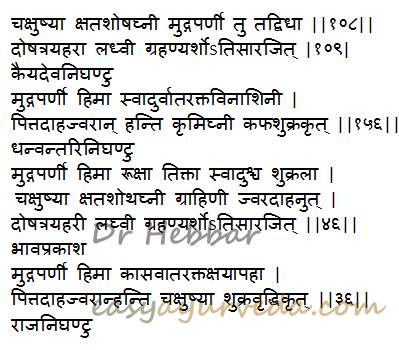Mudgaparni – Phaseolus trilobus Uses, Dose, Research
Mudgaparni – Phaseolus trilobus / Vigna trilobata is used in treating oligospermia, gout, gastritis, neuropathy, fever, worm infestation etc. It improves body weight.
Botanical name- Phaseolus trilobus Ait. (Vigna trilobata(L) Verde)
Family- Fabaceae (Simbi kula / Aparajita Upakula)
Table of Contents
Vernacular names
Names in different languages:
English name – Wild bean
Hindi name-Jangli moong, Mungvan
Telugu name- Adavi Pesalu
Bengali name – Mungani
Marathi name – Ranmug
Gujarati name – Adbad Mag, Jangli Mag
Sanskrit Synonyms
Mudgaparni, Shoorpaparni, Hamsi, Karangika,
Mrugagandha – having the smell of animal
Mahamarjara Gandhika – has smell of wild variety of cat
Shimbiringini, Shimbi, Shimbiparni – Legume
Vanaja, Vanamudga, Vanodbhava – Grows wildly in the forest
Kakamudga, Suryaparni, Ringini, Kurangika
Kshudrasaha, Hrasva, Alpa, – small plant
Mahasaha – It grow abundantly in forests
Classical categorization
Mudgaparni Classical Categorisation
charaka-
Jivaniya – enlivening group of herbs
Shukrajanana – Sperm production promoting group of herbs,
Madhura skandha – sweet group of herbs
Sushruta – Kakolyadi gana, Vidarigandhadi gana
Vagbhata- Sukrajanana, Vidarigandhadi gana
Kaiyadeva Nighantu –
Madhyama Panchamoola – Mudgaparni, Mashaparni, Bala, Punarnava, Eranda – Balances Kapha and Vata Dosha
Oshadhi Varga
Bhavaprakasha Nighantu, Rajanighantu, Dhanvantari Nighantu – Guduchyadi Varga
Chemical constituents
Phaseolus trilobus chemical Constituents:
Vitexin, Kaempferol, Luteolin, quercetin
Properties, part used, dosage
Vigna trilobata medicinal Properties
Guna (qualities) – Laghu – light to digest, Rooksha – Dryness
Rasa (taste) – Madhura – sweet
Vipaka- Madhura – sweet taste conversion after digestion
Veerya – Sheeta – Coolant
Effect on Tridosha – Balances all the three Dosha, slightly increases Kapha.
Pharmacological action – Anti inflammatory, Insecticidal, Aphrodisiac
Part used– Whole plant
Dosage– decoction 50-100 ml; powder 3-6 g
Sanskrit verse

Uses, indications
Mudgaparni – Phaseolus trilobus medicinal uses:
Chakshushya – improves vision, good for eyes, useful in eye disorders
Pittahara – useful in Pitta imbalance disorders such as gastritis, burning sensation, etc.
Grahi – absorbent, useful in diarrhea, IBS
Shukrakrut, Shukrala – improves sperm and semen quantity and quality
Shothaghna – relieves swelling, oedema, anti inflammatory
Indicated in –
Kshata – injury, bleeding
Shosha – emaciation
Grahani – IBS, sprue, altering diarrhea and constipation
Arsha – hemorrhoid’s
Atisara – diarrhea, dysentery
Vatarakta – Gout
Daha – burning sensation, as in gastritis, neuropathy, burning sensation in eyes etc.
Jwara – fever
Krumi – worm infestation
Kshaya – depletion of body tissues, weight loss, tuberculosis
It is indicated in menorrhagia, nasal bleeding.
External application:
The leaf, root paste is applied over wounds to check bleeding and to quicken healing
Side effects, Research
It is best to avoid this during constipation.
Research:
Hepatoprotective and anti oxidant activity – Experimental research study was conducted by H R Patel Women’s College of Pharmacy, Karwand Naka, Shirpur on hepatoprotective activity of methanol and aqueous extract of Phaseolus trilobus was evaluated by bile duct ligation induced liver fibrosis. Antioxidant activity was evaluated using in vitro and in vivo antioxidant models viz anti-lipid peroxidation assay, superoxide radical scavenging assay and glutathione estimation in liver. Liver function tests were carried out to detect hepatoprotective activity, which was further supported by histopathological examination. It was found out that Phaseolus trilobus possesses hepatoprotective property and is effective in oxidative stress induced cholestatic hepatic injury.
Interaction with medicines, supplements
Can this be used while taking Homeopathic medicine?
Yes. This product does not react with homeopathic medicine.
Can this medicine be continued while taking supplements like multivitamin tablets, Omega 3 fatty acids etc?
Yes. Generally, this product goes well with most dietary supplements. However, if you are taking more than one product per day, please consult your doctor for an opinion.
With western
medicines
Seek your
doctor’s advice if you are taking this product along with other western
(allopathic / modern) medicines. Some Ayurvedic herbs can interact with modern
medicine.
If both Ayurvedic and allopathic medicines are advised together, then it is
best to take Allopathic medicine first, wait for 30 minutes and then take the
Ayurvedic medicine.
Ayurvedic medicines
Ayurvedic medicines with Phaseolus trilobus as ingredient:
Click on the medicine name to know more about the medicine.
Dhanwanthararishtam – used in the treatment of low digestion power, low back ache. It is a very good uterine tonic. It is also useful in postnatal care of the mother.
Amruth Jeevan Rasayan – used in treatment of fatigue, low immune power etc
Vidaryadi Kashayam – used in respiratory conditions.
Bala Taila –used in Ayurvedic treatment of Vata diseases,vomiting, cough, cold, asthma, wound, emaciation etc. It is used both externally and orally.
Vasakasav – used for treating different types of inflammation and swollen conditions.
Different species
Vinga aconitifolia
Vinga adenanthus
Vinga pilos
Vinga antillania
Vinga gracilis
Morphology
Annual or perennial
Stem – Prostrate, slender, hairy
Leaves – Compound, Glabrous
Inflorescence – Few flowered raceme
Flowers – Yellow in colour
Fruits – Pods
Adulterant
Vinga pilosa
Phaseolus adenanthus
Sthanika Karma (Systemic Action)
External application
Relieve burning sensation, External application of the paste is indicated in inflammatory conditions, styptic, good for eyes. In menorrhagia conditions pichu can be done using it.
Internal administration-
Digestive System – Carminative, Absorbent . Indicated in Diarrhea, Malabsorption syndrome, Hemorrhoids etc.
Circulatory system – Acts as a blood purifier, indicated in bleeding disorders. indicated in vatarakat (gaut arthritis)
Reproductive system – Aphrodisiac, Indicated in sukrameha
Satmikarana – Indicated in general debility. Anti poisonous (Root powder is indicated in Animal poisoning (Mooshika visha))
Tapakrama – indicated in fever, burning sensation










